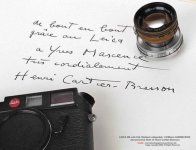50-60 years old.
2) Does it have flare issues?
Yes and no. It has more flare than a modern lens, because it's only single coated. But it is a pleasant glow.
You may see flare if you shoot in to the light, due to internal haze that has built up over the decades. I had my copy fully serviced by Leica and this made a huge improvement.
3) How's the look and character of the images it produces? I'm primarily shoot color negative. Is it something like modern Summicrons or something older and softer?
I produces a very classic look. Henri Cartier-Bresson used a collapsible Summicron from the mid 1950's until the end of his career, so take a look at some of his work. Contrast is moderate, colors are less saturated than with modern glass. Very sharp from about f5.6 up. Useable at f2, but don't expect miracles. This lens really shines, when shooting black and white.
4) How's the ergonimics? Handling the focus, aperture, etc
Depends on the user. The only thing that bothers me is that unlike a non-collapsible lens, you can't just set it to 3 meters and expect focus to stay there (within reason). So, I use a small piece of black cloth tape to lock it at the distance I want for scale focusing. On the other hand the big advantage is that once collapsed it allows you to comfortably carry an M body in your jacket pocket.
Here's the thing you need to know about this lens.
The coating on the front element is VERY SOFT. You will have a very had time finding an example that does not have wipe marks. The good news is that unless the damage is excessive and deep (scratches) it's not a big deal. Damage to the rear element is a lot more serious. When you clean this lens use fluid and the
gentlest touch. I basically rely on the weight of the wet tissue to do the work and drag it around the element.
Overall it's a great lens. Just keep in mind that it is almost 60 years old and while the performance is very good, it's not as good as later versions of the 50 Summicron. Basically your pictures will have a 1950/60's look.




